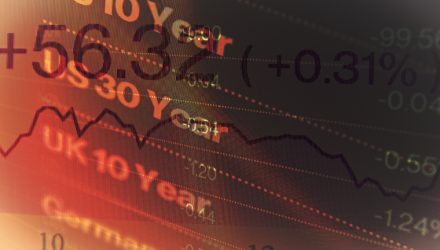The Fed’s pouring of funds into the high yield debt market makes for a stimulating portfolio play for investors looking to dial up the risk. As such, they can look at some high yield exchange-traded fund (ETF) options to satiate their appetites for fixed income.
“Buyers of junk-rated corporate bonds aren’t taking a vacation in August,” a Wall Street Journal report noted. “Issuance of U.S.-denominated high-yield bonds has already topped $44 billion this month, Moody’s Analytics estimates, setting a record for the typically slow August. That eclipses the previous high of $33 billion from August 2012.”
“The surge in issuance is a sign that the Federal Reserve’s bond-buying spree has helped resuscitate credit markets in the wake of the coronavirus pandemic, reopening the spigot for some of the riskiest corporate borrowers,” the report added.
10 Year Treasury Rate data by YCharts
High Yield Options in ETFs
Here are some high yield funds to consider for junk bond exposure:
- iShares iBoxx $ High Yield Corp Bond ETF (NYSEArca: HYG): HYG tracks the investment results of the Markit iBoxx® USD Liquid High Yield Index, which is comprised of high yield U.S. corporate bonds that have less than investment-grade quality.
- SPDR Bloomberg Barclays Short-Term High Yield Bond ETF (NYSEArca: SJNK): SJNK seeks to provide investment results that correspond generally to the price and yield performance of the Bloomberg Barclays US High Yield 350mn Cash Pay 0-5 Yr 2% Capped Index. SJNK invests its total assets in the securities comprising the index, which is designed to measure the performance of short-term publicly issued U.S. dollar-denominated high yield corporate bonds.
- iShares 0-5 Year High Yield Corp Bond ETF (NYSEArca: SHYG): SHYG seeks to track the investment results of the Markit iBoxx® USD Liquid High Yield 0-5 Index, which is primarily composed of U.S. dollar-denominated, high yield corporate bonds with remaining maturities of less than five years. Like SJNK, debt maturities are shorter, thereby helping to hedge some credit risk, but issues are still less than investment-grade.
For a high yield option to squeeze out that extra yield albeit more risk, take a look at the Goldman Sachs Access High Yield Corporate Bond ETF (GHYB). GHYB seeks to provide investment results that closely correspond, before fees and expenses, to the performance of the FTSE Goldman Sachs High Yield Corporate Bond Index.
The fund seeks to achieve its investment objective by investing at least 80% of its assets (exclusive of collateral held from securities lending) in securities included in its underlying index. The index is a rules-based index that is designed to measure the performance of high yield corporate bonds denominated in U.S. dollars that meet certain liquidity and fundamental screening criteria.
For more market trends, visit ETF Trends.









